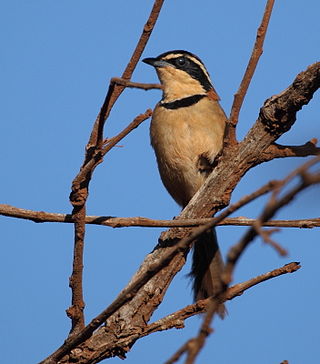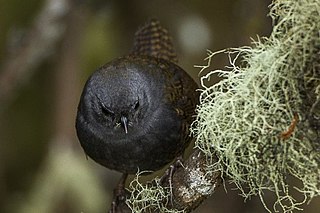
The gnateaters are a bird family, Conopophagidae, consisting of twelve small suboscine passerine species in two genera, which occur in South and Central America.

Formicariidae is a family of smallish suboscine passerine birds of subtropical and tropical Central and South America known as antthrushes. They are between 10 and 20 cm in length, and are most closely related to the ovenbirds in the family Furnariidae, and the tapaculos in the family Rhinocryptidae. The family Formicariidae contains 12 species in two genera.

Grallariidae is a family of smallish suboscine passerine birds of subtropical and tropical Central and South America known as antpittas. They are between 10 and 20 cm (4–8 in) in length, and are related to the antbirds, Thamnophilidae, and gnateaters, Conopophagidae.

The Tyranni (suboscines) are a suborder of passerine birds that includes more than 1,000 species, a large majority of which are South American. It is named after the type genus Tyrannus. These have a different anatomy of the syrinx musculature than the oscines, hence the common name of suboscines.

Niels Kaare Krabbe is a Danish ornithologist and bird conservationist for many years based at the Vertebrate Department of the Zoological Museum, University of Copenhagen and tutored by Jon Fjeldså. His research interests include various aspects of ornithology, especially bioacoustics, conservation, and systematics and altitudinal replacements of Scytalopus tapaculos. He has worked extensively in the Andes, especially Ecuador, and wrote the passerine section of Birds of the High Andes (1990) and the accounts of most Andean species in Threatened Birds of the Americas (1992). He has helped build up a large tissue collection in the Zoological Museum and has authored or coauthored several bioacoustic publications and peer-reviewed papers in scientific journals.

Pittasoma is a genus of birds in the gnateater family. Its two members breed in subtropical or tropical moist forest in South and Central America, specifically the Chocó, and Panama and Costa Rica. Formerly placed in the family Formicariidae, they were reclassified to Conopophagidae following analysis of mtDNA cytochrome b and NADH dehydrogenase subunit 2 sequences. The association between the genus Pittasoma and the 'traditional' gnateaters is also supported by traits in their natural history, morphology, vocalizations.

The Magellanic tapaculo is a small passerine bird in the tapaculo family Rhinocryptidae that is found in southern South America.

Scytalopus is a genus of small suboscine passerine birds belonging to the tapaculo family Rhinocryptidae. They are found in South and Central America from Tierra del Fuego to Costa Rica, but are absent from the Amazon Basin. They inhabit dense vegetation at or near ground-level and are mainly found in mountainous regions, particularly the Andes. They can be very difficult to see as they run through the undergrowth in a mouse-like fashion.

The crescentchests are a genus, Melanopareia, of suboscine passerine birds from South America. The genus has long been placed with the tapaculos in the family Rhinocryptidae. Their placement there has been questioned and in 2007 the genus was placed in its own family, Melanopareiidae, by the South American Classification Committee. Subsequently, the family was accepted by the International Ornithological Congress Bird List and the Clements Checklist. The family Melanopareiidae was formally erected in 2009.

The Bolivian tapaculo is a species of bird in the family Rhinocryptidae. It is found in Bolivia and Peru.

The Paramo tapaculo is a species of bird in the family Rhinocryptidae. It is found in the Andes of Ecuador and southern Colombia.

The mouse-coloured tapaculo or Serra do Mar tapaculo is a species of bird in the family Rhinocryptidae. It is endemic to humid highland forests in southeastern Brazil, where it ranges from southwestern Espírito Santo to northeastern Rio Grande do Sul. Most of its range is in the Serra do Mar, but it also occurs further inland in Paraná and Santa Catarina. Until 2005, the Planalto tapaculo was included in the mouse-coloured tapaculo.

The sandy gallito is a species of suboscine passerine bird in the family Rhinocryptidae, the tapaculos. It is the only species placed in the genus Teledromas. It is endemic to Argentina.

The Vilcabamba tapaculo is a small passerine bird in the family Rhinocryptidae. It is endemic to Peru.

The rock tapaculo or Espinhaço tapaculo is a species of bird in the family Rhinocryptidae. It is endemic to altitudes of 900–2,100 metres (3,000–6,900 ft) in the central and southern Espinhaço Mountains, and the Mantiqueira Mountains in Minas Gerais, Brazil, though it may also occur in adjacent parts of Rio de Janeiro and São Paulo. It is found in shrubby and grassy habitats in rocky regions, and in elfin and cloud forest. It closely resembles the Diamantina tapaculo and Planalto tapaculo in appearance and voice.

Tyrannides is a clade of passerine birds that are endemic to the Americas. The group likely originated in South America during the Eocene, about 45 million years ago.

The white-winged tapaculo is a species of bird in the tapaculo family, Rhinocryptidae. It was described in 2020 by the American ornithologist Tom Schulenberg and his colleagues. It is known only from north-central Peru, where it inhabits wet shrub forest and montane forest. White-winged tapaculos are small and drab birds, being mostly gray in color with brownish, barred upperparts and tails, and a distinctive patch of white on the wing. Adults are 10–11 cm (3.9–4.3 in) long; males weigh 18.0–20.8 g (0.63–0.73 oz) and females weigh 16.5–18.0 g (0.58–0.63 oz). Despite their relatively distinctive appearance, their cryptic nature means that they are typically best identified by their vocalizations.
















